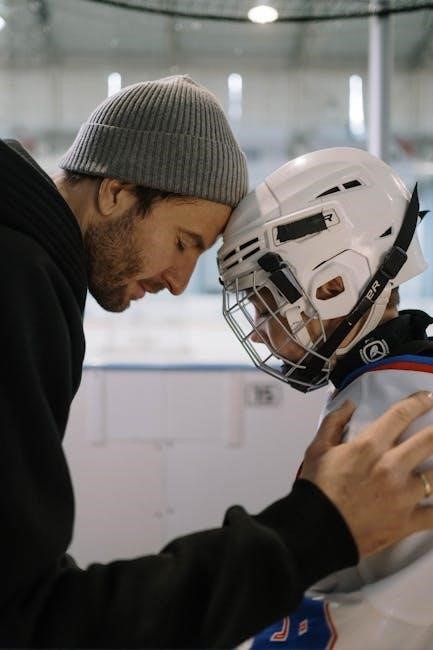Understanding Learning Disabilities
Learning disabilities are disorders affecting the acquisition, organization, or use of information, impacting skills like reading, writing, and math. They occur in individuals with average or above-average abilities.
1.1 Definition and Overview
Learning disabilities are neurological disorders that affect how individuals process information. They impact skills like reading, writing, math, and speaking, but are not tied to intelligence or effort. Conditions such as dyslexia, dysgraphia, and dyscalculia fall under this category. These disabilities affect the acquisition, organization, retention, or use of information, but individuals with LD often have average or above-average abilities. Early identification and support are key to helping individuals with LD thrive academically and personally.
1.2 Types of Learning Disabilities
Common types of learning disabilities include dyslexia, affecting reading and language processing; dysgraphia, impacting writing skills; and dyscalculia, involving math difficulties. Others like auditory and visual processing disorders interfere with sound or image interpretation. These conditions vary in severity and manifestation, requiring tailored support strategies. Understanding each type helps in developing effective interventions to assist individuals in overcoming their unique challenges.
1.3 Signs and Symptoms
Signs of learning disabilities vary but may include difficulty with reading, writing, or math, despite average or above-average intelligence. Students might struggle with comprehension, spelling, or organizational skills. Emotional or behavioral challenges, such as frustration or avoidance of academic tasks, can also indicate a learning disability. These difficulties often persist and can interfere with academic progress if not addressed. Early identification and support are crucial to helping individuals manage these challenges effectively.
1.4 Impact on Daily Life
Learning disabilities can significantly impact daily life, affecting academic performance, social interactions, and self-esteem. Individuals may struggle with time management, organization, and completing tasks, leading to frustration and anxiety. Socially, difficulties in communication or understanding others can create challenges in forming relationships. Emotional impacts, such as low self-esteem, may arise from ongoing struggles. However, with proper support and accommodations, individuals with learning disabilities can thrive and lead fulfilling lives, achieving their full potential in both academic and personal settings.

Positive Behaviour Support (PBS)
Positive Behaviour Support (PBS) is a proactive approach focusing on understanding and addressing the root causes of behaviours, improving quality of life and reducing challenging behaviours through person-centered strategies.
2.1 What is PBS?
Positive Behaviour Support (PBS) is a proactive approach focusing on understanding and addressing the root causes of challenging behaviours. It emphasizes improving quality of life by teaching new skills and reducing problem behaviours through person-centered strategies. PBS plans provide step-by-step guides for carers, ensuring individuals with learning disabilities lead fulfilling lives while minimizing behavioural challenges. This method prioritizes empathy, empowerment, and tailored interventions to create supportive environments.
2.2 The PBS Process
The PBS process begins with assessing the individual’s behaviour to identify triggers and underlying causes. Strategies are developed to teach alternative skills and reduce challenging behaviours. A personalized plan is created, focusing on positive reinforcement and environmental adjustments. The plan is implemented by carers, who monitor progress and adjust interventions as needed. Regular reviews ensure effectiveness, aiming to improve the individual’s quality of life and overall well-being. This structured approach ensures consistent support, fostering a positive and inclusive environment.
2.3 Benefits of PBS
PBS fosters empowerment by addressing the root causes of challenging behaviors, enhancing mental well-being, and promoting independence. It reduces problem behaviors by teaching adaptive skills, improving quality of life, and strengthening relationships. PBS also supports carers by providing clear strategies, reducing stress, and creating a positive environment. This approach ensures consistent, person-centered care, leading to long-term positive outcomes and increased community integration for individuals with learning disabilities.

Accessible Information
Accessible information involves tailoring content to meet individual needs, using clear language, visuals, and adaptive tools to ensure understanding and inclusivity for all learning styles and abilities.
3.1 Methods of Making Information Accessible
Methods to make information accessible include using clear and simple language, visuals, and adaptive tools. Providing information in multiple formats like large print, braille, or audio ensures inclusivity. Additionally, structured layouts with bullet points and headings help organize content, making it easier to understand. Incorporating visual aids like diagrams and pictures can also enhance comprehension for individuals with varying learning styles and abilities. These strategies ensure that information is accessible and usable for everyone, fostering an inclusive environment.
3.2 Tools and Resources
Various tools and resources can enhance accessibility for individuals with learning disabilities. Text-to-speech software, speech-to-text applications, and mind mapping tools help with reading, writing, and organization. Accessible document converters ensure materials are readable in multiple formats. Additionally, resources like readability tools and visual aids simplify complex information. These tools empower individuals to engage with content independently, fostering inclusivity and equal opportunities in education and daily life.

Health and Wellness
Annual health checks and mental health support are crucial for individuals with learning disabilities, ensuring early identification of issues and promoting overall well-being and quality of life.
4.1 Annual Health Checks
Annual health checks are essential for individuals with learning disabilities to monitor physical and mental well-being. These checks help identify potential health issues early, enabling timely interventions. They involve discussions with healthcare providers about lifestyle, nutrition, and any concerns. Regular screenings can detect conditions like diabetes or hypertension, improving overall health outcomes. These checks also provide an opportunity to address mental health, ensuring a holistic approach to wellness. Early detection and management of health issues can significantly enhance quality of life for individuals with learning disabilities.
4.2 Importance of Mental Health
Mental health is crucial for individuals with learning disabilities, as they often face unique challenges like anxiety, depression, or emotional distress. These conditions can arise from difficulties in school, social interactions, or stigma. Addressing mental health early is vital to improve overall well-being and quality of life. Accessible support, such as counseling or therapy, can help individuals cope with these challenges. Prioritizing mental health ensures they can thrive and lead fulfilling lives, fostering resilience and confidence in overcoming daily obstacles.

Educational Strategies
Effective teaching techniques, such as modeling and guided practice, help students with LD master skills. Collaborative learning and assistive technology further enhance their educational experience and independence.
5.1 Effective Teaching Techniques
Effective teaching techniques for students with LD include modeling and guided practice, allowing them to observe and replicate tasks. Multisensory approaches engage multiple learning pathways, enhancing retention. Differentiated instruction tailors lessons to individual needs, while formative assessments provide timely feedback, ensuring understanding. Incorporating assistive technology and collaborative learning fosters independence and confidence, creating an inclusive educational environment that addresses diverse learning styles and promotes academic success.
5.2 IEP/ILP Development
Developing an IEP/ILP involves collaboration between parents, educators, and professionals to create a personalized plan tailored to a student’s needs. The process begins with assessments to identify strengths and challenges, followed by setting measurable, achievable goals. The plan outlines accommodations, modifications, and strategies to support learning. Regular progress monitoring ensures goals are met, with annual reviews to update or adjust the plan. Involving the student in the process fosters self-advocacy and ownership of their learning journey, ensuring a comprehensive and effective educational pathway.
5.3 Accommodations in Education
Accommodations in education are adjustments made to help students with learning disabilities access learning materials and complete tasks. Examples include extended time for assignments, the use of assistive technology like text-to-speech software, and providing materials in alternate formats such as braille or large print. Accommodations also include environmental adjustments, like preferential seating or a quiet workspace. These adjustments ensure equal access to education without altering the academic standards, fostering an inclusive learning environment that supports each student’s unique needs and promotes academic success.

Legal Rights and Advocacy
Laws like IDEA and ADA protect individuals with learning disabilities, ensuring access to education and employment. Self-advocacy empowers individuals to assert their rights and seek support.
6.1 Laws Protecting Individuals with LD
Laws such as the Individuals with Disabilities Education Act (IDEA) and the Americans with Disabilities Act (ADA) protect the rights of individuals with learning disabilities. IDEA ensures access to special education services, while the ADA prohibits discrimination in education, employment, and public accommodations. Section 504 of the Rehabilitation Act requires reasonable accommodations in federally funded programs. These laws aim to promote inclusion and equal opportunities, ensuring individuals with LD can thrive in various settings.
6.2 Self-Advocacy Skills
Self-advocacy skills empower individuals with learning disabilities to communicate their needs and rights effectively. This includes understanding personal strengths and challenges, requesting accommodations, and making informed decisions. Key strategies involve articulating needs clearly, using tools like IEP/ILP documents, and knowing legal rights. Encouraging self-confidence and persistence helps individuals advocate for themselves in education and employment settings. Building self-determination skills fosters independence, enabling individuals to navigate challenges and seek support when needed, ensuring they thrive in various environments.
6.3 Community Resources and Support
Community resources and support play a vital role in helping individuals with learning disabilities thrive. Local organizations often provide workshops, support groups, and skill-building sessions tailored to their needs. Collaborations between schools, healthcare providers, and advocacy groups ensure comprehensive assistance; Accessible information, such as guides and FAQs, empowers individuals and caregivers. These resources foster independence, confidence, and inclusion, enabling individuals to navigate challenges effectively and lead fulfilling lives within their communities; They also offer a network of understanding and assistance, reducing barriers to success.

Assistive Technology
Assistive technology includes tools like text-to-speech software, speech-to-text, and mind mapping, aiding individuals with learning disabilities in reading, writing, and organizing information effectively.
7.1 Types of Assistive Technology
Assistive technology encompasses various tools designed to support individuals with learning disabilities. Text-to-speech software converts written text into spoken words, aiding those with reading difficulties. Speech-to-text tools enable verbal input to be transcribed into text, assisting with writing challenges. Mind mapping software helps organize thoughts visually, improving planning and brainstorming. Additionally, screen readers and font size adjusters enhance readability for individuals with visual processing issues. These technologies aim to create an inclusive learning environment by addressing diverse needs effectively.
7.2 Selecting the Right Technology
Selecting the right assistive technology involves assessing individual needs and preferences. Consider the ease of use, compatibility with existing systems, and cost. Involve the user in the decision-making process to ensure the technology aligns with their goals. Testing different tools can help identify the most suitable options. Additionally, training and support are crucial for effective use. Prioritize technologies that enhance independence, accessibility, and overall quality of life, while ensuring they integrate seamlessly into daily routines and educational environments.

Future Directions
Future directions in LD support emphasize innovative technologies, inclusive education, and comprehensive support systems, enabling individuals to thrive and reach their full potential effectively.
8.1 Research and Developments
Research into learning disabilities focuses on advancing understanding and support. Studies explore personalized interventions, assistive technologies, and inclusive education. Recent developments highlight the effectiveness of Positive Behaviour Support (PBS) plans in improving quality of life. Innovations in accessible information formats, such as clear language and visual aids, are also being refined. Additionally, advancements in early identification tools and mental health support systems aim to address challenges comprehensively. Ongoing research emphasizes collaboration between educators, healthcare providers, and technologists to create holistic solutions, ensuring individuals with LD can thrive in all aspects of life.
8.2 Promoting Inclusion
Promoting inclusion involves creating environments where individuals with learning disabilities feel valued and supported. This includes implementing inclusive education practices, ensuring accessible information, and fostering awareness in communities. Strategies like Positive Behaviour Support (PBS) plans and community resources help bridge gaps. Collaboration between educators, healthcare providers, and families is essential. By addressing communication differences and providing tailored support, society can empower individuals with LD to thrive. Inclusion ensures equal opportunities, helping them reach their full potential and live fulfilling lives.
